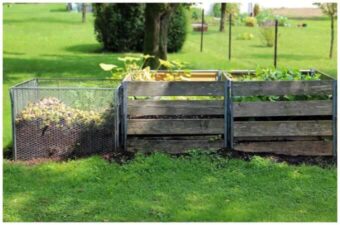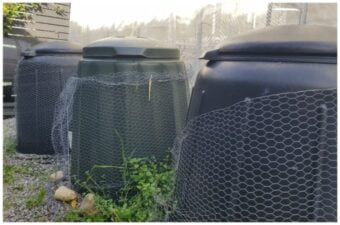Simplify Composting Oak Leaves: Your Essential Q&A Guide

Composting oak leaves is a valuable practice that not only benefits your garden but also contributes to a sustainable and eco-friendly lifestyle.
I first learned about the benefits of composting oak leaves from my neighbor, who had a beautiful vegetable garden. She showed me how she collected fallen leaves from her oak trees, composted them, and then used the finished product in her garden. After trying it myself, and learning from my mistakes, I became a believer in the power of composting oak leaves.
In this article, I will explore the most common questions about composting oak leaves and provide tips on how to create a successful compost pile.
For more in-depth info, please check our comprehensive guide: Composting for Beginners at Home.
Table of Contents
Can you compost oak leaves?
Yes, oak leaves can be composted. In fact, they are a great addition to a compost pile as they are rich in carbon and other nutrients that help to create a healthy soil environment.
While oak leaves are acidic when fresh, they become much closer to neutral as they break down in the compost pile. Some gardeners prefer to shred the oak leaves before adding them to the compost pile to speed up the decomposition process.
Oak leaves can also be composted with other yard waste such as grass clippings, vegetable scraps, and other fallen leaves.
By composting oak leaves, you can reduce waste, create nutrient-rich soil, and help to promote a healthy and sustainable environment.
Are there any special considerations when composting oak leaves?
Yes, there are some special considerations when composting oak leaves.
Oak leaves are acidic when fresh, but they become more neutral as they break down in the compost pile. However, if your soil is already acidic, adding too many oak leaves to your compost pile can make the soil even more acidic.
It’s important to balance the oak leaves with other materials that are more alkaline, such as grass clippings or vegetable scraps. Additionally, oak leaves are often tougher and more leathery than other types of leaves, which can make them slower to break down in the compost pile. Shredding the oak leaves before adding them to the pile can help to speed up the decomposition process.
Pine needles and oak leaves share some similar composting properties.
Can I compost diseased oak leaves?
Composting diseased oak leaves is generally not recommended.
Most home compost piles don’t reach the required temperatures of 150 to 180 degrees Fahrenheit to effectively kill plant disease pathogens. Consequently, composting diseased oak leaves without reaching these temperatures can result in the spread of disease in your garden.
For many home gardeners, it’s best to bury or haul away diseased oak leaves to prevent the spread of disease.
Can I compost black walnut leaves?
Yes, you can compost black walnut leaves.
While black walnut trees and their leaves contain juglone, a substance that is toxic to many plants, the toxin breaks down when exposed to air, water, and bacteria. The toxic effect can be degraded in two to four weeks, and in soil, breakdown may take up to two months.
Black walnut leaves may be composted separately, and the finished compost can be tested for toxicity before use.
How long does it take to compost oak leaves?
The time it takes to compost oak leaves can vary depending on several factors, including the size of the leaves, the moisture content of the pile, and the temperature of the pile.
In general, oak leaves can take anywhere from six months to two years to fully decompose in a compost pile.
To speed up the process, it’s important to turn the pile regularly to ensure that the leaves are evenly distributed and exposed to oxygen.
Shredding the oak leaves before adding them to the pile can also help to speed up the decomposition process.
Learn More: Composting Starters Demystified
Can I add coffee grounds to my compost pile that includes oak leaves?
Yes, you can add coffee grounds to your compost pile that includes oak leaves.
Coffee grounds are a great addition to a compost pile as they are rich in nitrogen, which helps to balance the carbon-rich oak leaves.
However, it’s important not to add too many coffee grounds to the pile, as this can make the pile too acidic. A good rule of thumb is to add no more than 25% coffee grounds to your compost pile.
Composting Oak Leaves Card
| Characteristic | Description |
|---|---|
| Carbon-to-Nitrogen Ratio | Oak leaves have a high carbon content, so they require nitrogen-rich materials to achieve a balanced composting process. |
| Decomposition Time | Oak leaves take longer to decompose compared to some other yard waste materials due to their higher carbon content. |
| Shredding | Shredding oak leaves before composting helps speed up the decomposition process and create a finer texture for easier use in the garden. |
| Mixing | Oak leaves should be mixed with other materials, such as grass clippings or food scraps, to ensure a balanced compost pile. |
| Tannins | Oak leaves contain tannin, which can slow down the decomposition process. Mixing oak leaves with other materials and adding nitrogen-rich materials can help overcome this challenge. |
| Disease Concerns | Avoid composting diseased oak leaves, as they can spread diseases to other plants. These leaves should be disposed of separately. |
| pH Effects | Oak leaves can affect the pH level of the compost. Testing the compost and adjusting pH, if necessary, can ensure optimal conditions for decomposition. |
| Mulching | Shredded oak leaves make excellent mulch, helping retain moisture, suppress weeds, and regulate soil temperature. |
| Nutrient Content | Composted oak leaves provide valuable nutrients and organic matter to the soil, improving its fertility and structure. |
How to compost oak leaves?
You can compost oak leaves using traditional composting methods or by employing worms for vermicomposting.
Traditional Composting
In the composting process, shredding oak leaves plays a crucial role in speeding up decomposition and creating a more uniform compost pile.
But, How to shred oak leaves for compost?
One of the easiest ways to shred oak leaves is to use a lawn mower with a mulching blade. Simply spread the oak leaves out on your lawn and mow over them with the mulching blade.
Another option is to use a leaf shredder, which is a machine designed specifically for shredding leaves. Some gardeners also use a wood chipper to shred oak leaves, although this can be a more expensive and time-consuming option.
In addition to shredding your oak leaves, here are other recommended steps:
- Mix the shredded leaves with other nitrogen-rich materials, such as grass clippings or food scraps, to create a balanced compost pile.
- Maintain moisture in the compost pile by regularly watering it, but avoid over-watering.
- Turn the compost pile regularly to provide oxygen and promote even decomposition.
- Monitor the temperature of the compost pile to ensure it stays within the optimal range of 120-160°F (49-71°C).
Composting Oak Leaves With Worms
Composting oak leaves with worms, also known as vermicomposting, is an excellent option. Here’s how to do it:
- Create a worm bin or purchase a dedicated vermicomposting system.
- Shred the oak leaves into smaller pieces to speed up decomposition and make it easier for the worms to process.
- Add a bedding material such as moist shredded newspaper or cardboard to the worm bin.
- Introduce composting worms, such as red wigglers, to the bin.
- Layer the shredded oak leaves on top of the bedding material, making sure to not overfeed the worms.
- Maintain the moisture level by misting the bin occasionally.
- Regularly add kitchen scraps and other compostable materials to provide a varied diet for the worms.
- The worms will consume the oak leaves along with other organic matter, producing nutrient-rich worm castings (vermicompost) as a result.
Read more: Earthworms Fun Facts: Nature’s Soil Engineers
Can I compost oak leaves in a plastic bag?
It is not recommended to compost oak leaves in a plastic bag, as this can prevent air and moisture from reaching the leaves and slow down the composting process. Instead, the leaves should be placed in a compost bin or piled up in a designated area.
How do I know when my oak leaf compost is finished?
The finished compost will be dark brown, crumbly, and have an earthy smell. You can also test the pH level to make sure it’s neutral or slightly acidic.
What is the best way to use composted oak leaves in the garden?
Composted oak leaves offer numerous benefits when used in the garden. Here are some ways to make the best use of them:
- Use composted oak leaves as a mulch around plants, creating a protective layer that retains moisture, suppresses weeds, and regulates soil temperature.
- Incorporate the composted oak leaves into the soil before planting. This will improve soil structure, drainage, and fertility.
- Top-dress existing plants with a thin layer of composted oak leaves, which provides a slow-release source of nutrients as it breaks down.
- Mix composted oak leaves with soil when starting seedlings for improved nutrient content and soil structure.
- Utilize composted oak leaves in vegetable gardens to provide essential nutrients for healthy plant growth and higher yields.
For more ideas on how to use your finished compost, be sure to check out The Beginner’s Guide to Adding Compost to Soil.
Summary
Composting oak leaves is a great way to create nutrient-rich soil for your garden, but it can be tricky.
In my early composting days, I made the mistake of adding a significant quantity of acidic oak leaves to my pile, resulting in negative effects on my plants. However, this experience taught me the importance of balancing oak leaves with other materials and shredding them beforehand.
By incorporating grass clippings or vegetable scraps and shredding the oak leaves, I witnessed a remarkable acceleration in the decomposition process.
By following these steps, you too can create a healthy and sustainable compost pile for your garden.








